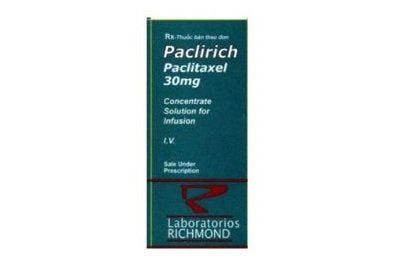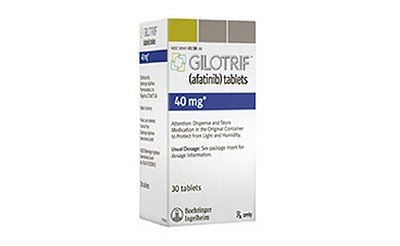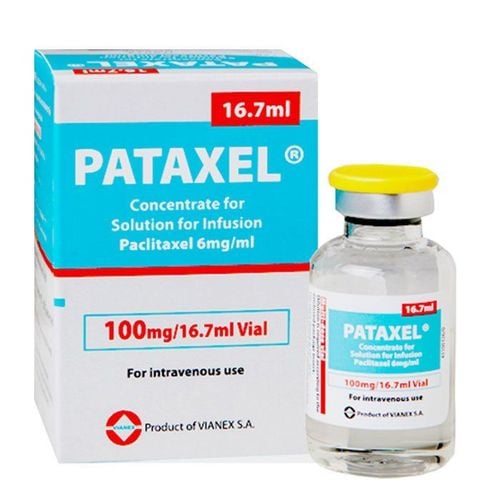This is an automatically translated article.
Aspaxel is a drug indicated in the treatment of ovarian cancer, breast cancer, and lung cancer. Below is all the information about the uses of Aspaxel, as well as how to use it, and the notes when using it that patients need to know when prescribed to use the drug effectively and safely.1. What is Aspaxel?
Aspaxel is a pharmaceutical product manufactured by S.C.Sindan-Pharma SRL of Romania and imported into Vietnam by Lien Hop Pharmaceutical Co., Ltd. registered responsible.This is a drug belonging to the group of anti-cancer drugs and affects the immune system with the active ingredient paclitaxel 30mg/5ml. The drug is often indicated in the treatment of ovarian cancer , breast cancer and lung cancer .
The drug is prepared in the form of a concentrated solution for intravenous infusion and is packaged in a box of 1 vial of 30mg (5ml) or 1 vial of 100mg (16.7ml).
2. Uses of Aspaxel
2.1. What does Aspaxel do?
The component paclitaxel is an anti-microtubule agent that increases the polymerization of tubulin dimers of microtubules and stabilizes them by preventing depolymerization. This stabilization inhibits the reorganization of the microtubule network, a phenomenon of cell survival during mitosis. Paclitaxel also increases the abnormal formation of bundles and vesicles of microtubules in the cell cycle, as well as the formation of multicellular structures (stellar bodies) of microtubules during cell division.Survey results show that patients taking paclitaxel have more benefits than taking the control drug because paclitaxel has less loss of appetite and less causes of peripheral neuropathy.
2.2. Point
Aspaxel is usually indicated in the treatment of the following cancers:Treatment of metastatic ovarian cancer when conventional treatments with platinum and anthracyclines have failed or are contraindicated. . The drug is used in combination with doxorubicin in the adjuvant treatment of metastatic breast cancer. Treatment of metastatic breast cancer alone in patients who have failed or failed to take anthracyclines or whose breast cancer has recurred within 6 months of adjuvant therapy. Treatment of advanced non-small cell lung cancer, AIDS-associated Kaposi's cancer.
2.3. Contraindications
Aspaxel is not recommended to be used in the following cases:Do not use in patients with hypersensitivity to paclitaxel or to any of its ingredients, especially hypersensitivity to polyoxyl castor oil 35. The drug does not used in patients with neutrophil counts < 1500/mm3 (1.5 x 109/liter) or signs of motor neuropathy. People who are pregnant or breast-feeding, children under 18 years old are not allowed to use this medicine.
3. Usage – Dosage
In order to use Aspaxel to achieve the best results in treatment, patients need to follow the correct use and dosage of the treating doctor.3.1. How to use
The preparation of drugs for intravenous infusion should be carried out by qualified and experienced personnel in an appropriate room. When mixing the drug, it is necessary to wear medical gloves and proceed with caution to avoid drug spillage and contact with skin and mucous membranes. If the skin is in contact with the drug, it is necessary to wash the skin thoroughly with soap and water immediately, and if the mucous membranes come into contact with the drug, rinse thoroughly with water. The preparation of the drug must be sterile and the solvent to dilute the drug can be: 0.9% sodium chloride solution, 5% glucose solution or a mixture of 0.9% sodium chloride solution with glucose solution 5. % or a mixture of 5% glucose solution with ringer solution. Usually, the drug will be mixed into one of the above solutions to get an infusion with a concentration of paclitaxel 0.3 - 1.2mg/ml. Use only infusion bottles made of glass, polypropylene or polyolefin and the infusion set must be made of polyethylene. And conduct the infusion immediately or within 3 hours after the preparation is complete, be careful not to put the mixed infusion in the refrigerator. During the preparation process, the infusion solution may be slightly cloudy due to the solvent of the preparation, so filtering will not make the solution clear. When infusion, the solution should be allowed to flow through a filter with a vial hole less than 0.22 micrometers on the infusion line, this will not affect the quality of the drug.3.2. Dosage
Before taking the drug, the patient needs to take some drugs first, such as: glucocorticoids (oral dexamethasone 12 hours and 6 hours before paclitaxel infusion), HI antihistamines (50mg diphenhydramine or 10mg intravenous chlorpheniramine) and T12 antihistamines (50mg). ranitidine or 300 mg cimetidine) intravenously 30 to 60 minutes before paclitaxel infusion.Treatment of ovarian cancer: First-line treatment: A combination of paclitaxel and cisplatin is recommended. Depending on the duration of the infusion, the recommended dose of paclitaxel is 175 mp/m2 administered intravenously over 3 hours, followed by cisplatin 75 mg/m2 every 3 weeks. Or 135mg/m2 paclitaxel IV over 24 hours, followed by cisplatin 75mg/m2 every 3 weeks. Second-line therapy: The recommended dose of paclitaxel is 175mg/m2 administered intravenously every 3 hours and every 3 weeks. 175mg/m2 administered intravenously over 3 hours, once every 3 weeks. Paclitaxel can be infused one day after the first dose of Trastuzumab, or immediately after the second dose of Trastuzumab if the first dose is well tolerated. Second-line therapy: The recommended dose of paclitaxel is 175 mg/m2 administered intravenously over 3 hours, once every 3 weeks. Treatment of advanced non-small cell lung cancer: The recommended dose of paclitaxel is 175 mg/m2 administered intravenously over 3 hours, followed by cisplatin 80 mg/m2 3 weeks apart. Depending on individual tolerability, the following dosing regimen should be used: Do not repeat paclitaxel unless WBC > 1500/mm3 and platelet > 100,000/mm3. Patients with severe leukopenia (<500/mm3 for 7 days or longer) or severe peripheral neuropathy on initial use should receive a 20% lower dose on subsequent treatments.
4. Side effects
Aspaxel medicine can cause some unwanted side effects for patients such as: bone marrow depression, hypotension, elevated liver enzymes, muscle and joint pain, digestive disorders, hair loss and peripheral neuropathy. .If you experience these side effects, you should immediately contact your doctor for treatment and appropriate dosage adjustment.
5. Drug interactions
Studies have shown that when paclitaxel (dose 110 - 200 mg/m2) and cisplatin (dose 59 - 75 mp/m2) are administered sequentially, when paclitaxel is infused before cisplatin, more myelosuppression is observed when paclitaxel is administered prior to cisplatin. In contrast, use Cisplatin first.Pharmacokinetic studies have shown that paclitaxel clearance is reduced by approximately 33% when paclitaxel is administered before cisplatin.
Based on in vitro data, co-administration of paclitaxel with ketoconazole may result in inhibition of paclitaxel metabolism. Therefore, caution should be exercised when paclitaxel is administered to patients receiving ketoconazole.
6. Caution
In patients with impaired or impaired liver function, the dose should be reduced. Paclitaxel is not recommended in cases where transaminases are increased 10 times the normal limit, or bilirubin is > 7.5 mg/100 ml or 5 times the normal limit. Use with caution in patients with heart disease. Cremophor EL is more likely to cause anaphylactoid reactions in people who are hypersensitive to cremophor EL. Therefore, anaphylaxis prophylaxis should be administered prior to treatment and good preparation should be made to be ready to respond to anaphylactic reactions when they occur. Use with caution in patients with a history of peripheral neuropathy. When infusion of multiple drugs, derivatives of paclitaxel, docetaxel should be used before platinum derivatives to reduce the risk of myelosuppression. Elderly people are often at increased risk of toxicity (neuropathy, agranulocytosis). Paclitaxel can cause harm to an unborn baby, so it should not be used by pregnant women. It is also not recommended for women who are breastfeeding because it is not known whether the drug passes into breast milk or not.7. Overdose and treatment
Initial signs of Paclitaxel include: myelosuppression, peripheral neuropathy, mucositis. Currently, there is no antidote for paclitaxel overdose, so patients with these symptoms should be prescribed drugs closely.In case of emergency and danger, it is necessary to contact the treating doctor and take the patient to the nearest hospital for emergency treatment and timely treatment.
8. Preservation of drugs
Store the medicine in a dry place with a room temperature below 30 degrees Celsius, the vial should be stored in its original packaging to ensure it is protected from sunlight. Medicines should be kept out of sight and reach of small children to prevent children from playing with and taking the wrong medicine, which can have dangerous effects on health.For the destruction of unused medicine or medicine packaging, do not throw it into the toilet or flush it under the household's tap. Contact your doctor or local waste disposal company for advice and instructions on how to safely dispose of the medication.
Above is all information about the uses, usage, dosage and notes when using Aspaxel that users need to know when prescribed the drug. From there, use the right medicine according to the doctor's prescription to achieve high efficiency in the treatment of the disease.
Please dial HOTLINE for more information or register for an appointment HERE. Download MyVinmec app to make appointments faster and to manage your bookings easily.













